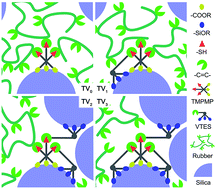Tailoring silica–rubber interactions by interface modifiers with multiple functional groups
Abstract
The filler–rubber interface is crucial in preparing ideal filled rubber composites. Interface modifiers are typically used for enhancing silica–rubber interactions and facilitating silica dispersion. In this work, trimethylolpropane tris(3-mercaptopropionate) (TMPMP) was found to be particularly effective in dispersing silica and the mechanism was investigated. Furthermore, the mercapto groups of TMPMP were reacted in gradient with the vinyl groups of vinyltriethoxysilane (VTES), which formed a series of interface modifiers with enhanced modifier–silica interactions and reduced modifier–rubber interactions. After applying the modifiers in silica filled rubber composites, the Payne effect, bound rubber content, dispersion morphology, mechanical and viscoelastic properties were studied. The results indicated that the interface modifiers with multiple functional groups were capable of purposefully balancing the interactions between rubber and silica, which brought about flexibility to optimize composite properties.



 Please wait while we load your content...
Please wait while we load your content...